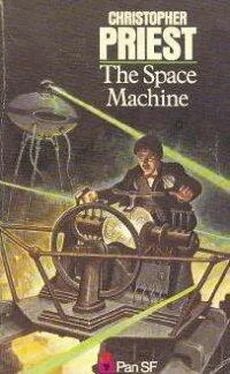I have mentioned that the city was circular in shape. We discovered this by accident and over a period of several days, and were able to confirm it later by ascending one of the taller buildings in the city.
Our first realization came as follows. On our second or third full day in Desolation City, Amelia and I were walking northwards through the city, intending to see if we could cross the mile or so of desert between us and the larger of the two industrial concentrations.
We came to a street which led directly northwards, seeming to open eventually on to the desert. This was in one of the populated areas of the city, and watch-towers abounded. I noticed, as we approached, that the tower nearest to the desert had stopped rotating to and fro, and I pointed this out to Amelia. We considered for a few moments whether or not to continue, but Amelia said she saw no harm.
However, as we passed the tower it was quite obvious that the man or men inside were rotating the observation-platform to watch us, and the dark, oval window at the front mutely followed our progress past it. No action was taken against us, so we continued, but with a distinct feeling of apprehension.
So taken were we with this silent monitoring that we fetched up unexpectedly and shockingly against the true perimeter of the city; this took the form of an invisible, or nearly invisible, wall, stretching from one side of the roadway to the other. Naturally enough, we thought at first that the substance was glass, but this could not be the case. Nor was it, indeed, any other form of material that we knew. Our best notion was that it was some kind of energetic field, induced by electrical means. It was, though, completely inert, and under the gaze of the watch-tower we made a few rudimentary attempts to fathom it. All we could feel was the impermeable, invisible barrier, cold to the touch.
Chastened, we walked back the way we had come.
On a later occasion, we walked through one of the empty quarters of the city, and found that there too the wall existed. Before long we had established that the wall extended all around the city, crossing not just streets but behind buildings too.
Later, from the aspect of the roof, we saw that few if any of the buildings lay beyond this circle.
It was Amelia who first posited a solution, linking this phenomenon with the undoubted one that air-density and overall temperature in the city were higher than outside. She suggested that the invisible barrier was not merely a wall, but in fact a hemisphere which covered the entire city. Beneath this, she said, air-pressure could be maintained at an acceptable level, and the effect of the sun through it would be closely akin to that of a glasshouse.
Desolation City was not, however, a prison. To leave it was as easy as it had been for us to enter it initially. On our journeys of exploration we came across several places where it was possible merely to walk through some specially maintained fault in the wall and enter the rarefied atmosphere of the desert.
One such fault was the series of doors and corridors at the railway terminus; there were similar ones at the wharves built by the canals, and some of these were immense structures by which imported materials could be taken into the city. Several of the major streets, which ran towards the industrial areas, had transit buildings through which people could pass freely.
What was most interesting of all, though, was that the vehicles of the city were able to pass directly through the wall without either hesitation or detectable leakage of the pressurized atmosphere. We saw this occur many times.
I must now turn the attention of this narrative towards the nature of these vehicles, for among the many marvels Amelia and I saw on Mars these numbered among the most amazing.
The fundamental difference lay in the fact that, unlike Earth engineers, the Martian inventors had dispensed with the wheel entirely. Having seen the efficiency of the Martians’ vehicles I was, indeed, forced to wonder how far Earthly developments in this field had been retarded by the obsession with the wheel! Furthermore, the only wheeled vehicles we saw on Mars were the crude hand-carts used by the slaves; an indication of how lowly the Martians considered such methods!
The first Martian vehicle we saw (not counting the train in which we had arrived, although we assumed that this too was without wheels) was the one which had raced through the streets that first dismal night in Desolation City. The second we saw was during the morning of the next day; that too was moving at such a lick that we were left with a confused impression of speed and noise. Later, however, we saw one moving more slowly, and later still we saw several at rest.
To say that Martian vehicles walked would be inaccurate, although I can think of no closer verb. Beneath the main body (which, according to its use, was designed in a fashion more or less conventional to us) were rows of long or short metal legs, the length being determined by the kind of use to which the vehicle was put. These legs were mounted in groups of three, connected by a transmission device to the main body, and powered from within by some hidden power source.
The motion of these legs was at once curiously life-like and rigidly mechanical: at any one time only one of the three legs of each mounting would be in contact with the ground. In motion, the legs would ripple with a quasi-peristaltic motion, the two raised legs reaching forward to take the load, the third one lifting and reaching forward in its turn.
The largest vehicle we saw at close quarters was a goods-haulage machine, with two parallel rows of sixteen groups of these legs. The smallest machines, which were used to police the city, had two rows of three groups.
Each leg, on close examination, turned out to be made of several dozen finely-machined disks, balanced on top of each other like a pile of pennies, and yet activated in some way by an electrical current. As each of the legs was encased in a transparent integument, it was possible to see the, device in operation, but how each movement was controlled was beyond us. In any event, the efficiency of these machines was in no doubt: we frequently saw the policing-vehicles driving through the streets at a velocity well in excess of anything a horse-drawn vehicle could attain.
Perhaps even more puzzling to us than the design of these vehicles was the men who drove them.
That men were inside them was apparent, for on many occasions we saw ordinary Martians speaking to the driver or other occupants, with spoken replies coming through a metal grille set in the side of the machine. What was also quite clear was that the drivers were in positions of extraordinary authority, for when addressed by them the Martians in the street adopted a cowed or respectful manner, and spoke in subdued tones. However, at no time did we see the drivers, for all the vehicles were totally enclosed—at least, the driver’s compartment was enclosed—with only a piece of the black glass set at the front, behind which the driver presumably stood or sat. As these windows were similar to those we saw on every watch-tower, we presumed that they were operated by the same group of people.
Nor were all the vehicles as prosaic as maybe I have made them appear.
Confronted, as we were, with a multitude of strange sights, Amelia and I were constantly trying to find Earthly parallels for what we saw. It is likely, therefore, that many of the assumptions we made at this time were incorrect. It was relatively safe to assume that the vehicles we thought of as drays were just that, for we saw them performing similar tasks to those we knew on Earth. There was no way, though, of finding an Earthly equivalent for some of the machines.
Читать дальше











